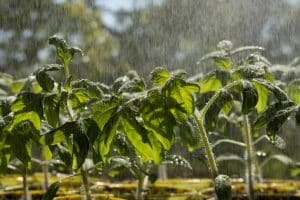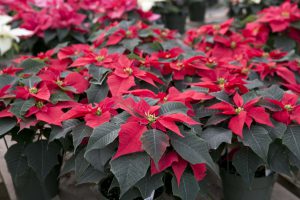
Droughts and Gardens
Water, Water, and More Water
Fertilizer, Weeds, and Other Care
Lawns
Plant a Drought Tolerant Garden
“We never know the worth of water till the well is dry.”
Thomas Fuller
Drought happens. It’s not pretty, it’s not pleasant, but it happens. Our luscious, green foliages fade to a dull and crispy brown. Our flowers wilt away or don’t even bloom. Our plants become weak, powerless to defend themselves against pests, diseases, or possibly winter. It doesn’t have to be a death sentence for our plants, though. Despite all that can happen, we as gardeners can help our plants thrive even in the dry heat. Here’s how:
Water, Water, and More Water:
Plants typically need about an inch of water per week to keep them happy and healthy. But when the air becomes dry and the sun is beating down on our soil, water tends to evaporate much faster. Regularly check your soil to ensure it stays moist. Don’t lightly water every day, though. One or two long, deep soakings of the soil will better supply your plants with the moisture they need.
As a general rule, water when the first couple of inches feel dry to the touch. Use a soaker hose and set it right on the soil to do its work. Don’t rely on a sprinkler. In the hot sun, half of the water will evaporate before it even makes it to the ground. Another half will end up on the foliage, where it isn’t needed.
To keep the water from evaporating in the hot sun, mulching is key. It creates a barrier between your soil and the sun, cooling the surface and keeping moisture right where it needs to be. Simply spread a 2-3″ layer throughout your garden for best results.
Fertilizer, Weeds, and Other Care:
In a time of drought, we want to help our plants flourish. Typically, fertilizer is a great way to do this. But when the rain is gone, the fertilizer should be, too. Fertilizer encourages plants to grow. Larger plants need more water. If the water isn’t there, then it’s senseless and pointless growth.
Fertilizer salts also need water to dissolve so our plants can absorb them. If they can’t dissolve, the salts can cause build-up in the soil. When buildup happens, fertilizer can burn your precious plants’ roots. Drought care is about less burning and more thriving, so just set the fertilizer aside for a bit.
Nothing is worse than the heat of a drought; your plants can attest to that. The last thing you’ll want to do is weed your garden. As tough as it is, though, it has to be done. Weeds also need water to grow. If they’re in your beds, they’re pulling precious water from the plants you want, so pluck them out.
Dig in with Alberta’s Best Gardening Blog for more great insights on home gardening!
Lawns:
Lawns aren’t my favourite thing. If you have one and love it, though, it can be devastating to watch the green turn brown. The good news is that lawns are made to bounce back. Sure, they may look brown and crunchy for a bit, but when the rain comes again, so will the green. With water in shorter supply, don’t waste it on a lawn that will flourish on its own. Leave the watering in the garden where it’s most needed for less hardy flowers and foliage.
When you mow, raise your blades a few inches higher than you would normally keep them. Blades that are cut short won’t have as much moisture, making them easier to die. Keeping the grass a little longer will keep it moist and green for longer.
Plant a Drought Tolerant Garden:
If you find yourself facing a drought problem year after year, it’s high time to consider planting in preparation. There are plenty of plants that can’t stand the heat, but plenty more that can. Consider planting varieties with proven drought tolerance.
Native plants are particularly good at this. These plants are from here, and they know how to grow here without human interference. If they can do this, that probably means they know a little about a drought. You won’t need to worry about their watering needs as much.
There’s plenty of sufferings in a drought; your garden doesn’t have to be one of them. For more tips and tricks for drought gardening, or to browse our selection of drought-tolerant plants, visit the greenhouse today.















